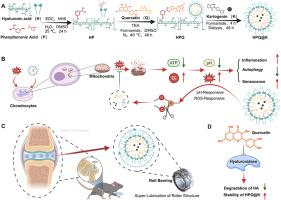Integrating superlubricative nanomaterials with precision drug delivery for advanced osteoarthritis therapy
IF 10.2
1区 医学
Q1 ENGINEERING, BIOMEDICAL
引用次数: 0
Abstract
Osteoarthritis (OA) is a degenerative joint disorder characterized by chronic inflammation, impaired lubrication, and progressive cartilage degradation. To address these multifaceted pathologies, we developed a multifunctional nanoparticle, termed HPQ@K, based on hyaluronic acid (HA), for co-delivery of quercetin (QUT) — a compound with anti-inflammatory, antioxidant, and hyaluronidase properties — and kartogenin (KGN), which induces chondroautophagy and cartilage regeneration. QUT was conjugated to HA through reactive oxygen species (ROS)- and pH-sensitive boronate ester linkages, leading to self-assembled micelles that encapsulate KGN and enable stimulus-responsive drug release under inflammatory OA conditions. HPQ@K retains the innate lubricity and biocompatibility of HA, while exhibiting enhanced resistance to enzymatic degradation, thereby prolonging its joint residence time. Its nanospheric structure ensures uniform articular coverage and combines hydration lubrication with a "ball-bearing" effect to achieve superlubricity. In murine chondrocytes, OA models, and human cartilage tissues, HPQ@K enhanced drug bioavailability and enabled spatiotemporally controlled release, mitigating oxidative stress, restoring mitochondrial function, promoting autophagy, and reducing cellular senescence. Furthermore, it significantly lowered friction coefficients and protected cartilage from mechanical damage. Collectively, HPQ@K constitutes an all-in-one nanotherapeutic platform that concurrently targets inflammation, restores joint lubrication, and facilitates cartilage repair, offering a comprehensive triple-therapy strategy for advanced OA.

将超润滑纳米材料与精密给药相结合用于晚期骨关节炎治疗
骨关节炎(OA)是一种以慢性炎症、润滑受损和进行性软骨退化为特征的退行性关节疾病。为了解决这些多方面的病理,我们开发了一种多功能纳米颗粒,称为HPQ@K,基于透明质酸(HA),用于共同递送槲皮素(QUT) -一种具有抗炎、抗氧化和透明质酸酶特性的化合物-和诱导软骨自噬和软骨再生的促核原(KGN)。QUT通过活性氧(ROS)和ph敏感的硼酸酯键与HA结合,导致自组装胶束包裹KGN,使炎症性OA条件下的刺激反应性药物释放。HPQ@K保留了透明质酸的天然润滑性和生物相容性,同时表现出增强的酶降解抗性,从而延长了其联合停留时间。它的纳米球结构确保了均匀的关节覆盖,并将水合润滑与“球轴承”效果相结合,以实现超润滑。在小鼠软骨细胞、OA模型和人软骨组织中,HPQ@K提高了药物的生物利用度,实现了时空控制释放,减轻氧化应激,恢复线粒体功能,促进自噬,减少细胞衰老。此外,它显著降低摩擦系数,保护软骨免受机械损伤。总的来说,HPQ@K构成了一个一体化的纳米治疗平台,同时靶向炎症,恢复关节润滑,促进软骨修复,为晚期OA提供了全面的三联治疗策略。
本文章由计算机程序翻译,如有差异,请以英文原文为准。
求助全文
约1分钟内获得全文
求助全文
来源期刊

Materials Today Bio
Multiple-
CiteScore
8.30
自引率
4.90%
发文量
303
审稿时长
30 days
期刊介绍:
Materials Today Bio is a multidisciplinary journal that specializes in the intersection between biology and materials science, chemistry, physics, engineering, and medicine. It covers various aspects such as the design and assembly of new structures, their interaction with biological systems, functionalization, bioimaging, therapies, and diagnostics in healthcare. The journal aims to showcase the most significant advancements and discoveries in this field. As part of the Materials Today family, Materials Today Bio provides rigorous peer review, quick decision-making, and high visibility for authors. It is indexed in Scopus, PubMed Central, Emerging Sources, Citation Index (ESCI), and Directory of Open Access Journals (DOAJ).
 求助内容:
求助内容: 应助结果提醒方式:
应助结果提醒方式:


